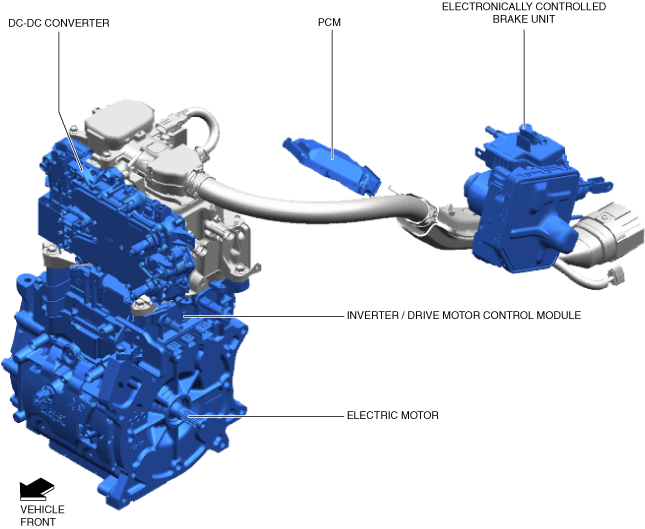 |
a30zzn00001213
EV SYSTEM OUTLINE
id300000000200
OUTLINE
Specification
|
Item |
Specification |
||
|---|---|---|---|
|
Electric motor
|
Model
|
MH
|
|
|
Type
|
AC cycle electric motor
(Permanent magnet type synchronous electric motor)
|
||
|
Maximum output
|
(kW)
|
107
|
|
|
Maximum torque
|
(Nm)
|
270
|
|
|
High voltage battery
|
Type
|
Lithium-ion battery
|
|
|
Quantity (module)
|
16
|
||
|
Battery total voltage
|
355 V
|
||
|
Connection type
|
Series
|
||
|
Capacity
|
(Ah)
|
100
|
|
|
Cooling type
|
Refrigerant type
|
||
|
Cooling system
|
Cooling type
|
Water-cooled type
|
|
|
Water pump
|
Type
|
Electric
|
|
|
Accelerator pedal position sensor
|
Hall element type
|
||
|
Electric motor temperature sensor
|
Thermistor type
|
||
|
Electric motor speed sensor
|
Resolver type
|
||
Structural view
L.H.D.
a30zzn00001213
|
R.H.D.
a30zzn00002251
|
a30zzn00001214
|
Component parts
|
Component parts |
Outline |
|---|---|
|
PCM
|
• Calculates drive force required by user and controls electric motor output.
• Monitors high voltage battery conditions (voltage, current, charging condition, and temperature).
• Controls DC-DC converter to supply power to vehicle's electrical devices.
• Controls coolant discharge amount of electric water pump.
• Controls cooling fan airflow volume.
• Determines insulation condition of high voltage circuit based on monitoring results of electrical leakage detection device in BECM.
|
|
Electric motor
|
• Generates drive force using electrical power from high voltage battery during driving.
• Acts as a regenerative brake during deceleration to recover vehicle’s kinetic energy.
|
|
Inverter
|
• Performs the followings by driving internal power transistors.
|
|
Drive motor control module
|
• Controls power transistors in inverter based on conditions of inverter and electric motor and electric motor requested torque from PCM.
• Detects conditions of electric motor and inverter, and transmits it to PCM.
|
|
DC-DC converter
|
• Steps down 355 V DC of high voltage battery to 14 V DC to supply power to accessories and to charge lead-acid battery.
|
|
High voltage battery
|
• Supplies power to electric motor.
• Stores electrical power regenerated by electric motor.
|
|
BECM
|
• BECM monitors the following high voltage battery conditions.
• Detects insulation condition of high voltage circuit by electrical leakage detection device in BECM and inputs it to PCM.
|
|
Battery charge control module
|
• During normal charging, converts alternating current supplied from charge port to direct current for charging high voltage battery.
• During charging, communicates with charging system and transmits communication content to PCM via CAN communication.
|
|
Charge port-electrical supply unit
|
• Drives and performs illumination control of following parts installed to charge port.
• During rapid charging, measures charge port temperature using charge inlet temperature sensor, and transmits it to PCM via CAN communication.
|
|
Electronically controlled brake unit
|
• During braking, calculates regenerative braking force, and transmits regenerative braking request to PCM and controls hydraulic braking force.
• While TSC or DSC is operating, transmits request signal for braking force control to PCM.
|